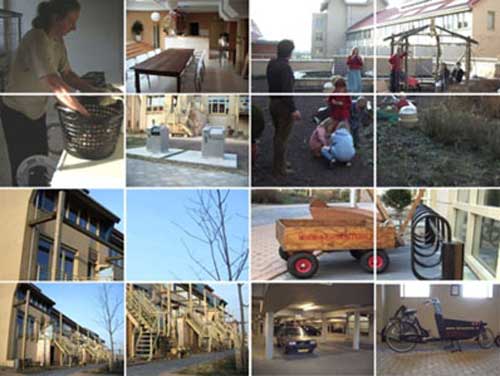SUSTAINABLE HOUSING AND LIVING PROJECT DE KERSENTUIN

An environmentally, socially and economically sustainable neigbourhood in the city of Utrecht, founded and developed by the inhabitants themselves.
Key Innovation
A socially and environmentally sustainable neighbourhood which was set up by the inhabitants themselves.
Problematic background and context
A group of people wanted to live in socially and ecologically sustainable neighbourhood, but that didn’t exist. So, seven people took initiative to start a neighbourhood like this. After a year and a half of making plans, the city of Utrecht was willing to cooperate. In this time, the group that worked on the plans (the future inhabitants) grew. A location was found, Leidsche Rijn, a new neighbourhood in a suburb of Utrecht.
Solution description
The aim of the solution is to have an ecologically and socially sustainable neighbourhood. Environmentally friendly houses for diverse groups of people (families, elderly), with good contact between neighbours, lots of social activities, where everything is organized by the inhabitants themselves.
The solution came to life after the initiators made a plan which was approved by the city, after which the building phase could start in cooperation with the housing association.
There are two aspects: housing and social. The houses are environmentally friendly (sustainable materials, solar power, ventilation system, etc.). The inhabitants take initiative for all activities (ie. green-group) and new services (ie. car sharing, handcart, carry bike, etc.) in the neighborhood, which is very socially active.
Timeframe
December, 2004
Development phase
There are not many cases exactly like this, but there are cases which can be compared to this one, mainly on the area of environmentally friendly housing.
Revenue/costs model
Inhabitants:
– pay for their parkingplace to association ‘De Kersentuin’
– pay contribution to association ‘De Kersentuin’
– who rent a home have to pay rent to ‘Portaal’, the housing association
– who buy a house have to pay maintenance costs to the owners association
– pay for al the services the inhabitants use (handcart, carsharing, etc.)
Social evaluation
There is a number of benefits for the society: there are fewer cars in the neighbourhood which causes a more child-friendly place, there is a more diverse group of inhabitants, there are lots of activities to bring and keep people together, there is lots of social contact within the neighbourhood, there is lots of social control, there are more and more innovative initiatives, the inhabitants have a better sight on the ‘big picture’ and they feel more like a part of a whole.
Environmental evaluation
More over, there are a number of benefits for the environment. First off, the inhabitants set up a car-sharing project. Secondly, there are lots of green areas which are maintained by inhabitants themselves and by hired forces and private gardens are shared. People share facilities like environmentally friendly washing machines. There are several systems to provide economic use of natural sources (solar cells for energy and rain water for domestic use).
Economical evaluation
Benefits for economy are less obvious than benefits for society and the environment. Economic benefits will probably be of a secondary nature, in the sense that initiatives that originate in “De Kersentuin” might be suited to apply on a larger scale on a commercial level.
There is direct economic benefit for the inhabitants themselves. By organizing certain services themselves and by sharing facilities they save a lot of money. In the future, it will even be possible for inhabitants to receive money from the power company for any energy they produce extra from roof-top solar cells.
Authors
Joris Zaalberg / TU Eindhoven / Netherlands